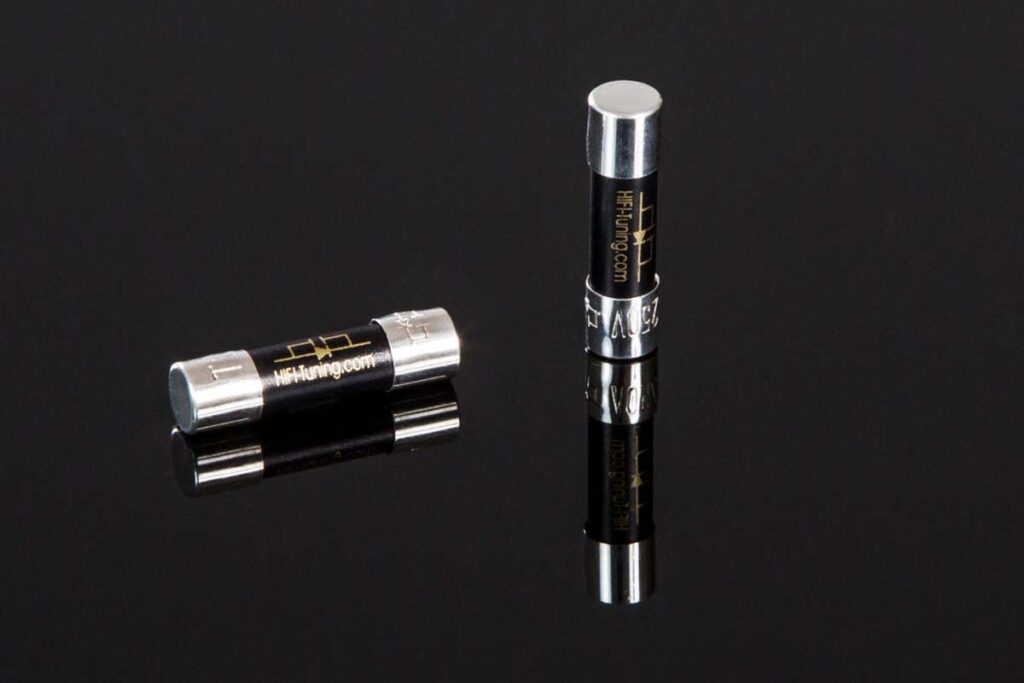The USA has been building hype around micro fuses for years. The standard factory ones, available from major electronics retailers for 20 cents a pop, are out of fashion. And here come the fuses with precious metal-plated contacts and equally fancy internals. In turn, the price points can easily reach three or even four figures in dollars or euros.

But is this just some marketing magic for manufacturers like HiFi-Tuning? Far from it. Rather, it’s smart tuning in a place where it makes perfect sense. After all, the current that brings our beloved arsenal of entertainment to life must pass through the fuse. The effect of “clean” power on the sound of a setup is no longer a debate—the positive effect of mains filters is a fact. On the other hand, the fuses continue to polarize opinion, even though it seems logical to examine all stages of unimpeded power flow and improve them where appropriate.
Sieveking, a company specializing in audiophile listening material and equipment, such as the magnificent products from Audia Flight, recently added fuses from Berlin-based HiFi-Tuning to its range. They confidently call themselves “Supreme³” or “US-Supreme³,” are reasonably priced at 60 and 99 euros respectively, and are truly capable of making a good system even better. For this review, I ordered the “silver/gold” version of the Supreme³, with end caps coated in an alloy consisting of 99% silver and 1% gold. The goal is to minimize the transition resistance that inevitably occurs between the fuses and the circuitry. This optimizes the flow of current and widens the potential “bottleneck” as much as possible for better sound.
HiFi tuning = fuse tuning
However, we must be clear here—the replacement doesn’t mark a transition from night to day. Instead, fuse tuning compares to the sound improvement of replacing a quality power cord with a dedicated high-end cable. In other words, an optimized micro fuse isn’t going to turn a mediocre-sounding device into a top performer. But it can help expand the potential of an already excellent setup beyond what was previously possible.
With this in mind, a pair of US Supreme³ fuses found their way into my Mark Levinson No. 27 power amplifier. And, after lengthy repairs (nearly a complete rebuild) in Harald Pensel’s MuSiCa-NoVa workshop, it is now awaiting its official “rebirth.” In such a powerful amplifier, we place a large burden on the micro fuses, because they are confronted with fairly high currents. As it turns out, the four-ampere versions from HiFi-Tuning perform this task with flying colors, making this exquisite power amplifier sound even more homogeneous, confident, and harmonious than before. It’s worth noting that this amplifier’s circuit design goes back to sound guru John Curl, who installed a consistent dual mono concept on the dinky rubber feet.
Anything but pointless
Unlike other iconic amplifiers of the era, the ML No. 27 is a decidedly refined instrument and a true marvel of resolution. At the same time, it has enough power to drive challenging speakers such as the large Infinity Kappa, whose extremely low impedance can easily push even powerful the limits of amplifiers.
The No. 27 has excellent manners combined with a lot of backbone, so the money spent on the Supreme³ is anything but wasted. Quite the contrary—the timbres become a touch more vibrant, the sonic contours a little clearer and the virtual space deeper and wider. Admittedly, these are only nuances, but they are nuances that count, and that distinguish the extraordinary from the “just” very good.
As I’m writing this review, the usual Christmas (market) madness is raging outside my house, which is why I put the CD Best of Pentatonix Christmas into the player, featuring one of the most ingenious cover versions of all time: Leonard Cohen’s “Hallelujah” in an almost overproduced a cappella version. It pounds, it murmurs, it grooves mercilessly and is electrifyingly immediate. After replacing the fuse, the toe-tapping factor has increased by even more percentage points, the grin on my face deepens, and so do the laugh lines. All of this because of micro fuses that cost less than many an audiophile vinyl or silver disc. I’d call these a sensible investment. But be careful: tampering with the power supply of a hi-fi device can endanger life and limb and also void the warranty. If you don’t feel confident replacing the fuse yourself, then it’s better contact a trusted specialist workshop to ensure you can enjoy your music without regret.

HiFi-Tuning Supreme³ and US-Supreme³
Concept: Micro fuses, available in all common formats | Prices: from €60
Sieveking Sound
Plantage 20
28215 Bremen, Germany
Phone +49 6848930


